As the popularity of building a pickleball court or converting a tennis court for pickleball use continues to grow, choosing the right color combination for your pickleball court can be challenging due to the numerous options available.
This guide aims to provide you with helpful insights into creating an ideal color scheme for your pickleball court.
When planning to install an outdoor pickleball court, it’s essential to consider various factors, including the court’s color. This article explores different options for choosing the color of your pickleball court.
Do Not Forget to Read: What Is A Fault In Pickleball?
Do Not Forget to Read: Latest Pickleball Paddles
Pickleball Court Color Schemes
Choosing the right color combination for a pickleball court is essential to ensure that the court stands out, is easily recognizable, and provides a welcoming environment for players.
The color of the court not only affects the aesthetic appeal of the playing area, but it can also impact the game itself. The lines on the court and the color of the ball must be distinguishable to players for a fair and efficient game.
Therefore, it’s crucial to consider the color combinations that stand out and provide good contrast against each other.
Bright colors like yellow, orange, and green are the most popular choices for pickleball courts, as they provide a bold contrast and help maintain visibility of the lines in any lighting condition.
These colors are also ideal for outdoor courts as they provide visibility in direct sunlight. Additionally, having a vibrant color palette adds to the overall inviting atmosphere of the court.
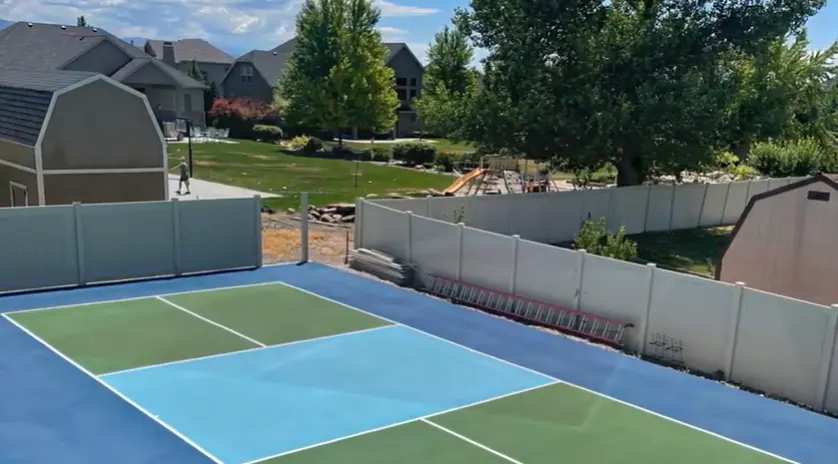
However, traditional colors like blue and green are still commonly used and remain a popular choice for pickleball courts. It’s essential to keep in mind that the colors chosen for the court must harmonize with the lines on the court and the color of the pickleball ball itself.
With about 18 standard colors available, there are hundreds of color combinations to choose from.
Do Not Forget to Read: can you play pickleball on concrete
Most Commonly Used Colors for Pickleball Courts
According to the USAPA guidelines, the court color should contrast with the ball and the lines. This means that any color can be used for pickleball courts as long as it harmonizes with the ball and lines. However, blue and green are the most commonly used colors for pickleball courts.
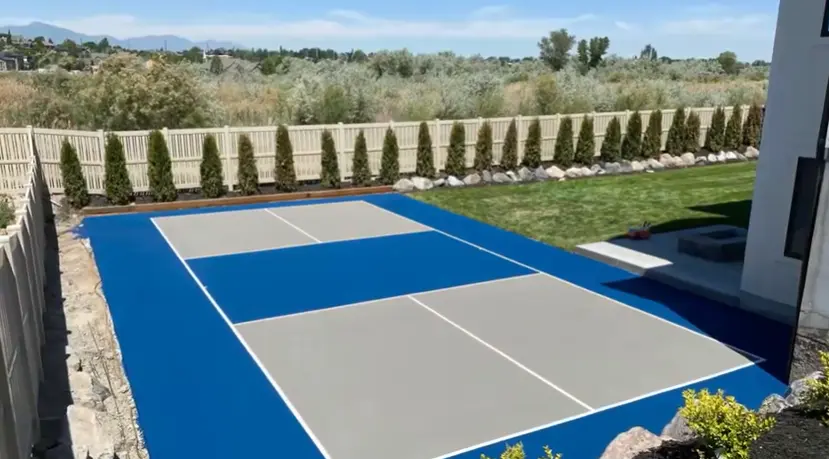
Jeff Gearheart, a pickleball court builder, suggests that lighter colored courts are more popular in hotter climates because they reflect more sunlight and can be cooler. This is important to consider for outdoor pickleball courts, especially in areas with hot weather conditions.
It is also important to choose a court color that contrasts with the color of the ball for better playability. Pickleball balls are generally yellow or lime green, so having a court color that contrasts with these colors can enhance the playing experience for players.
Other color options for pickleball courts include reds, purples, and various shades of blues and greens.
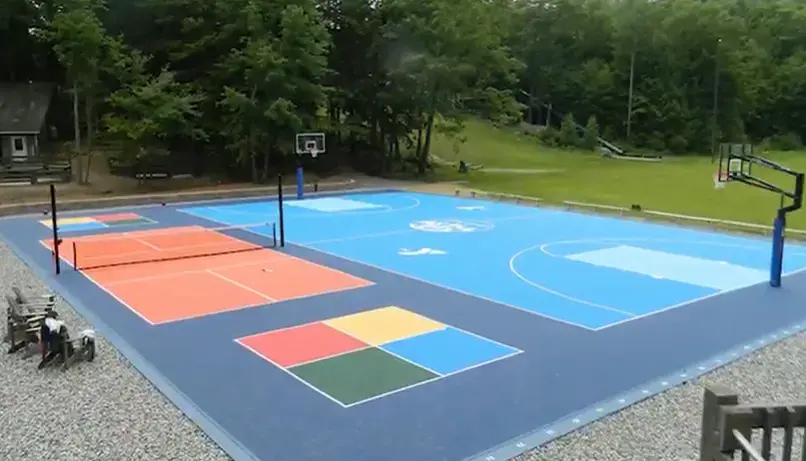
There are about 18 standard colors for pickleball courts, including maroon, red, bright red, orange, yellow, sandstone, beige, dove gray, gray, ice blue, light blue, blue, light green, forest green, dark green, tournament purple, and black. Color combinations can also be created by mixing and matching these standard colors.
Importance of Color Harmony
Choosing the right color combination for a pickleball court is crucial for enhancing the playing experience for players. Color harmony is important because it creates a cohesive and visually appealing court.
The right color combination can also make it easier for players to track the ball during the game.
When choosing a court color, it is important to consider the surrounding environment and any buildings or structures nearby. The court color should complement the surroundings and enhance the overall aesthetics of the area.
Importance of Choosing Colors That Stand Out
One of the main reasons to choose colors that stand out is to improve the visibility of the ball during gameplay.
The ball used in pickleball is typically a bright color such as yellow or lime green, and choosing a court color that contrasts with the ball can make it easier for players to track the ball’s movement. This can result in better gameplay and a more enjoyable experience for everyone involved.
Additionally, choosing colors that stand out can make the court more visually appealing and add an element of excitement to the game. Vibrant colors can create a fun and energetic atmosphere, which can enhance the overall experience for players and spectators alike.
Benefits of Having a Vibrant Color Palette
Having a vibrant color palette for your pickleball court can have several benefits. First and foremost, it can help to attract more players to your court.
People are often drawn to colorful and visually appealing spaces, and having a bright and inviting court can make it more likely that people will want to play.
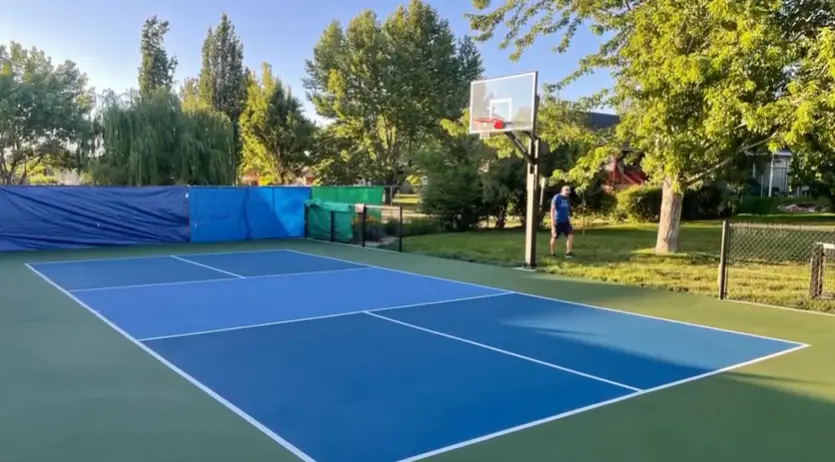
Furthermore, a vibrant color palette can help to create a sense of community and foster a positive atmosphere. Players may feel more energized and engaged when playing on a brightly colored court, which can lead to increased socialization and a stronger sense of camaraderie among players.
Do Not Forget to Read: Can You Play Pickleball On A Tennis Court
Tape Stripe as an Alternative to Traditional Paint Markings for Pickleball Courts
When it comes to designing a pickleball court, traditional paint markings are not the only option available. Tape stripe color design is a great alternative to traditional paint markings for pickleball courts.
Tape stripes are durable, easy to apply, and require low maintenance. Moreover, they can add a touch of creativity and color to your court that traditional paint markings cannot.
Benefits of Using Tape Stripes
One of the key benefits of using tape stripes is their durability. Tape stripes are known to last much longer than painted lines. They can withstand harsh weather conditions, heavy foot traffic, and even the frequent impact of pickleball balls.
They also require low maintenance, which means that once they are applied, they do not require frequent touch-ups or repairs.
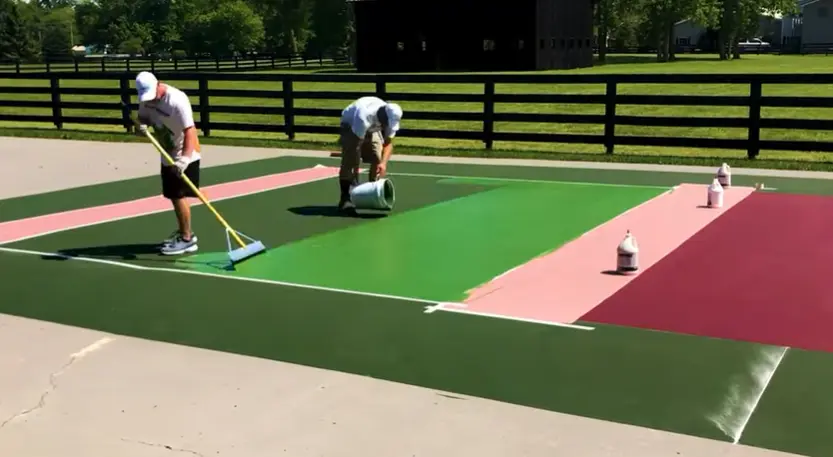
Another benefit of using tape stripes is their easy application process. Unlike traditional paint markings, which require a significant amount of time and effort, tape stripes are easy to apply.
They can be applied quickly and efficiently with the help of a line taping machine, and can even be applied without the assistance of a professional. This makes tape stripes a cost-effective option for designing a pickleball court.
Recommendations for Tape Stripe Colors
When selecting colors for tape stripes, it is important to look for colors that stand out without clashing too much. The contrast between the colors of the tape stripes and the court surface can make a significant difference in the visibility of the court markings.
The United States of America Pickleball Association (USAPA) recommends white-colored boundary lines for Pickleball courts. The most important thing to keep in mind while coloring the boundary lines should always be the contrast of the court surface.
A classic choice for tape stripe colors is a white-yellow combination, which provides a high contrast against the court surface and the ball. However, other colors such as red, blue, or green can also be used for tape stripes.
These colors can be mixed and matched to create unique and vibrant color combinations that stand out on the court.
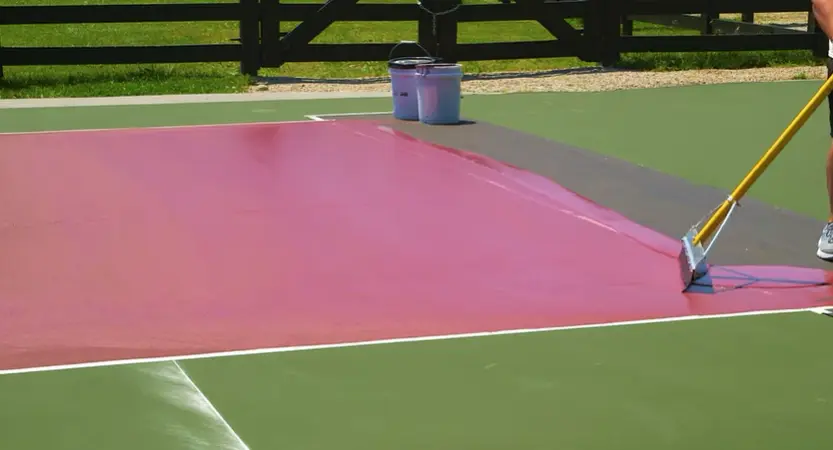
Importance of considering lighting and sun conditions for pickleball courts color scheme
When it comes to designing a pickleball court, choosing the right colors is not just about aesthetics. It’s also important to consider the lighting and sun conditions of the court.
The right color scheme can improve visibility, reduce glare, and enhance the playing experience.
Best Color Choices For Different Lighting Conditions
Different lighting conditions require different color choices. In indoor courts, bright and bold colors can be used to create a vibrant atmosphere. In contrast, outdoor courts require more subdued colors to reduce glare and avoid visual strain.
For courts with harsh sunlight, light-colored surfaces are the best choice as they reflect the sun’s rays and keep the court cooler. For courts in shaded areas, darker colors can be used to provide better contrast.
Avoiding dark colors
While dark colors may look visually appealing, they are not the best choice for pickleball courts as they tend to absorb more heat and increase the temperature of the court.
This can make the playing experience uncomfortable, especially in hot weather conditions. Dark colors can also create a visual strain on the eyes, especially for older players. Therefore, it is recommended to avoid dark colors for pickleball courts.
The importance of lighting
Lighting is an important factor to consider when it comes to the color scheme of pickleball courts. Proper lighting can enhance visibility and reduce eye strain for players. Brighter lighting can make colors appear more vibrant and distinguishable.
To get the best results, it is recommended to use LED lighting with a color temperature of 5000K for indoor courts. For outdoor courts, it is best to use lighting that mimics natural daylight.
A Helpful Guide: How Much Does It Cost To Build A Pickleball Court?
Selecting High-Quality Pickleball Court Paints with Good UV Protection
As with any sport, the quality of the equipment and facilities can have a significant impact on the experience of the players. When it comes to the pickleball court, the type of paint used is particularly important.
UV Protection
One of the most important factors to consider when selecting paint for a pickleball court is the level of UV protection it provides. The sun’s UV rays can cause paint to fade and deteriorate over time, which can lead to the need for frequent repainting.
Additionally, exposure to UV radiation can cause the court to become slippery, which can be dangerous for players.
High-quality pickleball court paints that offer good UV protection will not only last longer, but they will also help to ensure that the court remains safe and playable for a longer period of time.
These paints are typically formulated with special additives that protect against UV damage, which means that they will maintain their color and texture over time.
Selecting One Base Color with Complementary Trim or Secondary Colors
When selecting the paint for a pickleball court, it is also important to consider the color scheme. Many pickleball courts are painted with a single base color, which provides a uniform look and helps to create a sense of continuity across the court.
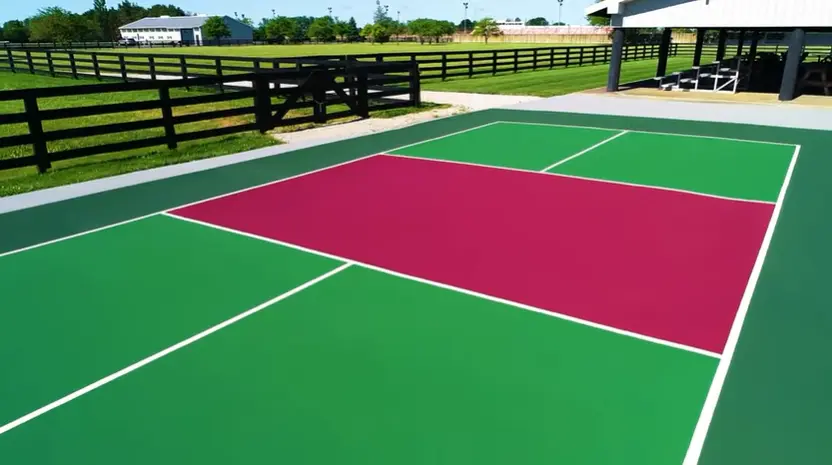
However, some courts also incorporate complementary trim or secondary colors to add visual interest and enhance the overall look of the court.
When selecting these colors, it is important to choose shades that work well together and complement each other. This can help to create a visually appealing and harmonious court that players will enjoy using.
How To Apply Primer And Line Paint Between Rows Of Tape
If you are planning to paint a court surface, it is important to apply the primer and line paint properly between rows of tape to ensure a smooth, even finish. Here are the steps to follow:
Applying Stripe Right Primer:
- Use a paintbrush or small roller to apply a stripe right primer between the rows of tape.
- Ensure that some of the material is forced onto each side of the tape to seal off any voids prior to painting.
- The roller can be taped to prevent it from rolling and producing a nicer look while also preventing paint splatter.
- Let the stripe right primer dry completely and ensure that it is clear in appearance before proceeding to the next step.
Applying Line Paint:
- Use a brush or roller to apply the line paint carefully.
- Take care not to go outside the lines and create smudges or uneven marks.
- Let the line paint dry completely before removing the masking tape.
Removing Masking Tape to Avoid Adhesive Marks:
- Remove all masking tape before the line paint is completely dried.
- If the masking tape is left on the court surface overnight, it can leave adhesive marks.
- Carefully remove the tape by pulling it back at a 45-degree angle from the painted surface.
- If any adhesive residue is left behind, use a cloth or sponge with a mild soap solution to remove it.
By following these steps, you can achieve a professional-looking finish for your court surface painting project. Remember to take your time and be patient during the painting process to ensure that the primer and line paint are applied evenly and smoothly.
Do Not Forget to Read: Pickleball Spin Serve Rules

Michael Stevenson
Hi, my name is Michael Stevenson and I’m a passionate pickleball player. I’ve been playing the game for many years and I’m pretty highly skilled at it. Pickleball is one of my favorite topics so naturally, I love to write about it.
Whether it’s tips for beginners, guides for experts, reviews of new paddles, or advanced playing techniques – if it relates to pickleball then I have something interesting to write about it. So if you’re looking for entertaining and informative information on the topic of pickleball, look no further than my written works!